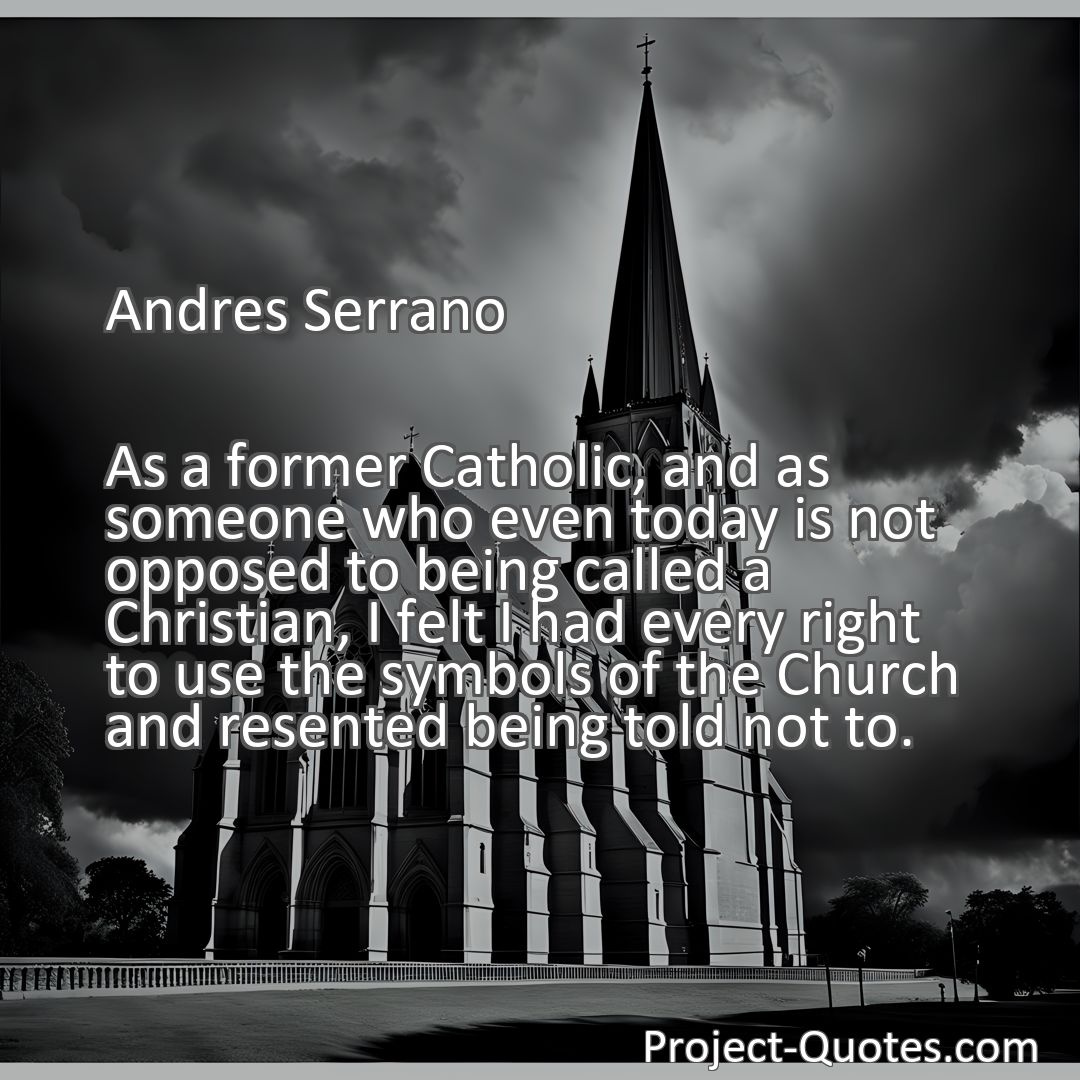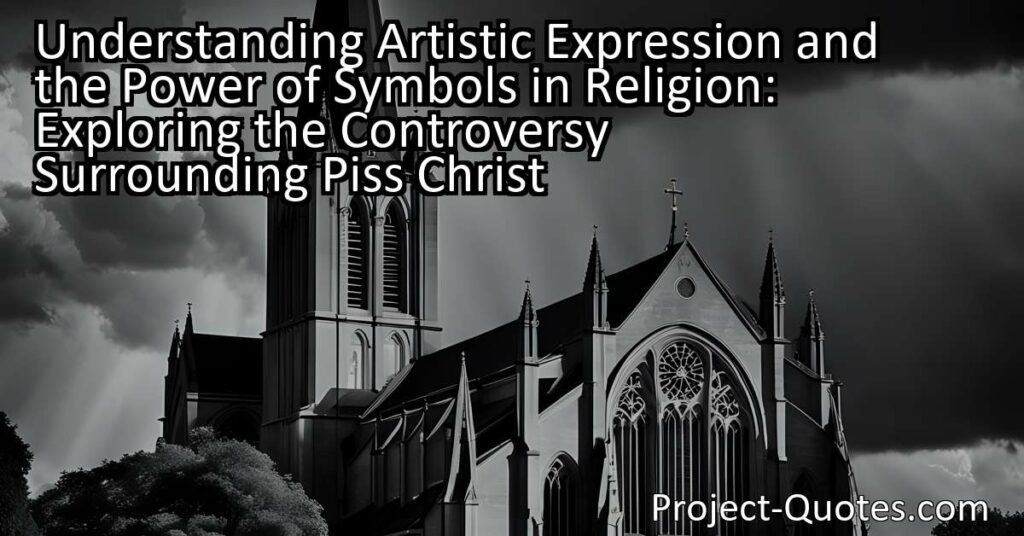As a former Catholic, and as someone who even today is not opposed to being called a Christian, I felt I had every right to use the symbols of the Church and resented being told not to.
Andres Serrano
The artwork “Piss Christ” by Andres Serrano sparked immense controversy due to its use of religious symbolism. The photograph, depicting a plastic crucifix submerged in urine, ignited debates about artistic expression, freedom of speech, and religious sensitivity. This controversy highlights the complex relationship between art and religion, emphasizing the importance of understanding and respecting diverse perspectives.
Table of Contents
- 1 As a former Catholic, and as someone who even today is not opposed to being called a Christian, I felt I had every right to use the symbols of the Church and resented being told not to.
- 2 Andres Serrano
- 3 Meaning of Quote – As a former Catholic, and as someone who even today is not opposed to being called a Christian, I felt I had every right to use the symbols of the Church and resented being told not to.
- 4 Freely Shareable Quote Image
- 5 Related
Meaning of Quote – As a former Catholic, and as someone who even today is not opposed to being called a Christian, I felt I had every right to use the symbols of the Church and resented being told not to.
Understanding Artistic Expression and the Power of Symbols in Religion
Introduction:
Art has long served as a medium of human expression, allowing individuals to convey their beliefs, emotions, and experiences. In the realm of religious art, symbols hold immense significance, representing deep-rooted faith, cultural heritage, and personal spiritual connection. However, the incorporation and interpretation of religious symbols in art can be highly contentious, as demonstrated by the quote from Andres Serrano, a former Catholic artist. In this article, we will explore the complex relationship between art, religion, and the use of symbols, highlighting the importance of understanding and respecting different perspectives.
The Nature of Artistic Expression:
Artistic expression is a powerful tool that enables individuals to communicate and provoke thoughts and emotions. Artists often draw inspiration from their personal experiences, beliefs, and culture, using symbols to enrich their work. These symbols can serve as visual metaphors, representing ideas that go beyond their literal meaning. They possess the ability to evoke strong emotions, challenge conventions, and stimulate discussions.
Andres Serrano’s Experience:
Andres Serrano, a renowned contemporary artist, identifies as someone who is not opposed to being called a Christian, though he is a former Catholic. In his quote, Serrano expresses his frustration at being told not to use symbols of the Church in his artwork. His statement reflects a clash between the freedom of artistic expression and religious sensitivities.
Religion and Symbolism:
Religion, throughout history, has utilized symbols as a means of expressing its deep-rooted beliefs and practices. Icons, statues, and rituals form an integral part of religious worship. These symbols act as visual aids, facilitating spiritual connection and fostering a sense of community among believers. The power of these symbols lies in the shared meaning and significance they hold for the faithful. They evoke devotion, awe, and a sense of transcendence.
The Role of Controversial Artworks:
Controversial artworks, such as those incorporating religious symbols, often challenge societal norms and question established beliefs. Serrano’s use of religious imagery in his artwork, particularly his most famous photograph, “Piss Christ,” sparked immense controversy and criticism. The photograph depicts a small plastic crucifix submerged in the artist’s urine, intended to provoke discussion about the commercialization and commodification of religious symbols.
Art and its Interpretation:
Art can be subjective, with each viewer interpreting it differently based on their own experiences, values, and religious affiliations. While Serrano may have intended to raise questions about the commercial aspect of religion, many within the Christian community found the artwork blasphemous. It ignited debates about the boundaries of artistic expression, freedom of speech, and religious sensitivity.
Balance between Artistic Freedom and Respect:
The clash between artistic freedom and religious sensitivity raises important questions about the fine line between expressing oneself and respecting others’ beliefs. It is crucial to acknowledge that the use of religious symbols in art can be deeply personal and hold great significance for believers. Artists have a responsibility to consider the potential impact their work may have on others, as the right to freedom of expression must be exercised with compassion and empathy.
Promoting Dialogue and Understanding:
Rather than dismissing or condemning controversial artwork outright, it is essential to foster dialogue and promote understanding between artists and religious communities. Education and open-mindedness play key roles in cultivating a society that respects and appreciates diverse perspectives. By engaging in thoughtful conversations, both artists and believers can deepen their understanding of each other’s viewpoints, leading to greater mutual respect and tolerance.
Conclusion:
Art has the power to engage, challenge, and provoke, often pushing boundaries within society. The interaction between art and religion, particularly the use of religious symbols, remains a complex and sensitive topic. Andres Serrano’s experience sheds light on the sometimes contentious relationship between artists and religious communities, highlighting the need for empathy, dialogue, and mutual respect. By understanding the symbolic and personal significance of religious imagery in art, we can navigate these conversations more thoughtfully, encouraging a diverse and inclusive artistic landscape.
I hope this quote inspired image brings you hope and peace. Share it with someone who needs it today!


